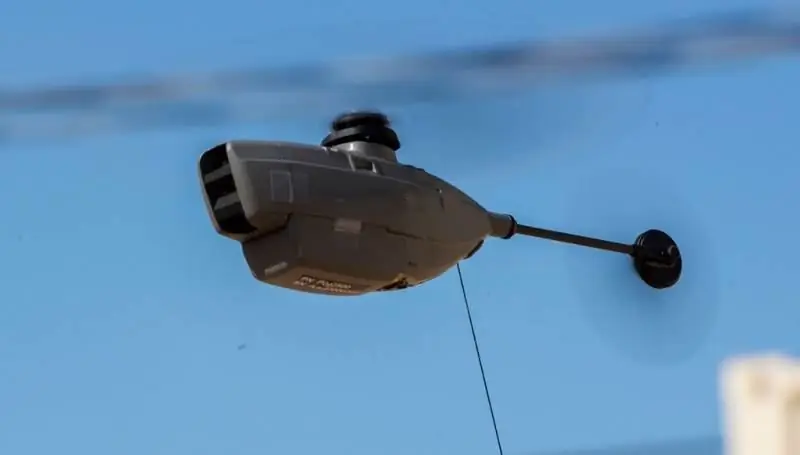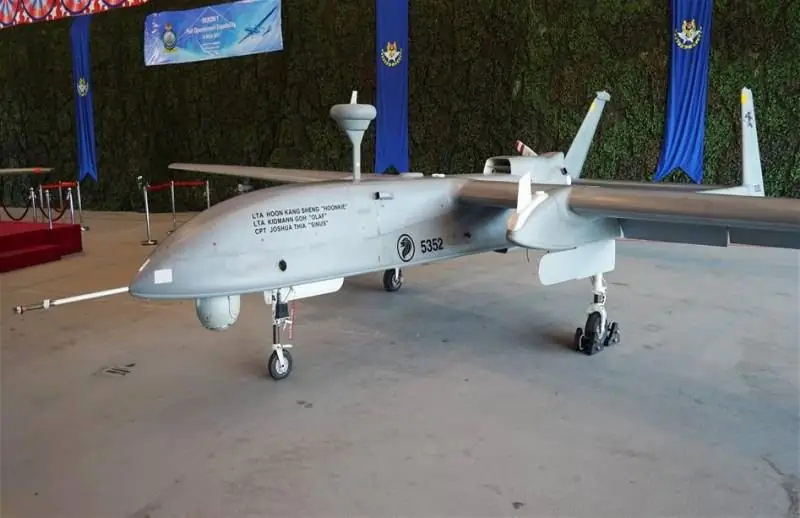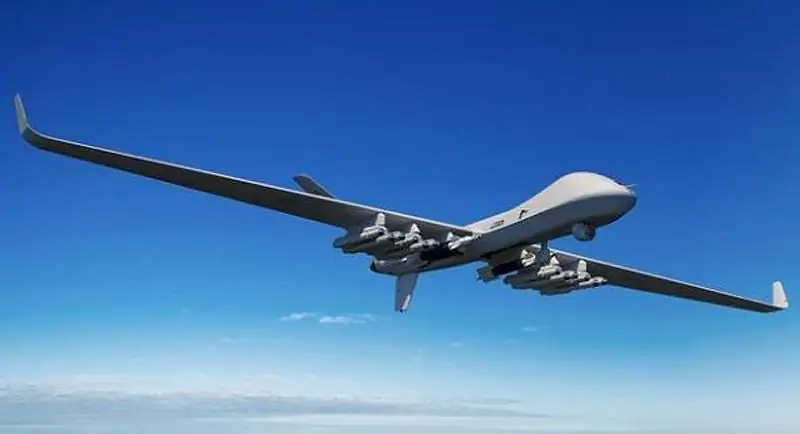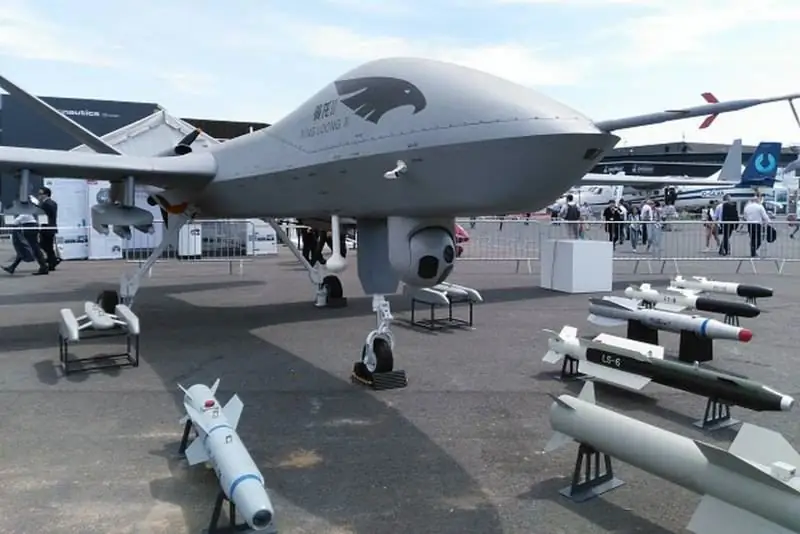- Author Matthew Elmers [email protected].
- Public 2023-12-16 21:49.
- Last modified 2025-01-24 09:17.

This process, however, is not pure innovation, as government and industry seek to develop new capabilities that provide advantages over potential adversaries. One of the most important aspects of this is the development of new hybrid configurations that eliminate the inequality of opportunity between the generally accepted categories of unmanned vehicles - air, ground, surface and underwater.
For example, the BAE Systems company presented the concept of a new adaptable UAV (AUAV), which in the air can switch between aircraft and helicopter modes, depending on the objectives of the task being performed. While there are many hybrid UAVs with separate lift and thrust engines, and there are several tiltrotor models and even tail-landing vehicles, the AUAV concept is quite different.
The company presented a short video of the deployment of a swarm of drones in the task of suppressing enemy air defense. The strike UAV operator detects the launch position of surface-to-air missiles and issues a command to the device to drop the container by parachute, after which it opens like a shell and releases six drones that take the shape of a toroid with wide, slightly tapering wings with propellers at their leading edges. They slide down a boom fixed in the center of the container and fly out in airplane mode to search and destroy their targets, which remotely control missile launchers. By distributing targets among themselves, they temporarily disable them in what is most likely a jet of foam covering the sensors.
After completing the task, they return to another bar mounted on the turret of the tank, located at a safe distance. Shortly before returning, they switch to a helicopter flight due to the flip of one of the propellers from the leading edge of the wing to the rear, which forces the UAV to rotate around its vertical axis. Then they slow down, hover over the bar and "sit" on it one by one. The video also shows, as an alternative, their return in the same way to the surfaced submarine.
The transition between the two modes of operation may require adaptive flight control software, while advanced autonomy would allow them to adapt to rapidly changing situations in the future battlefield, operate in a swarm mode to mislead advanced air defenses, and operate in complex urban spaces.
The launch and return boom allows the adaptable UAVs to operate from a wide variety of launch platforms in challenging environments likely to be crowded with people, vehicles and aircraft. BAE Systems says the boom restricts the lateral movement of the UAV so that strong winds cannot knock them down and therefore reduces the risk of injury to people nearby. The boom is gyro-stabilized to ensure its vertical position, even if the carrier vehicle is standing on a slope or the ship is swinging on the waves.
Another promising area is the development of advanced flight control systems. For example, the experimental stealthy jet UAV MAGMA, the first flight of which was announced in December 2017. Its main highlight is the use of a unique high pressure air blowing system instead of moving control surfaces. It not only eliminates moving surfaces that can increase visibility, but also eliminates the complex mechanical, hydraulic and electrical systems required to operate the aircraft in flight.
The company noted that this technology, in addition to reducing weight, reducing maintenance costs and simplifying design, could provide better control, paving the way for lighter, less visible, faster and more efficient aircraft, both civil and military, both manned and and unmanned.
In terms of MAGMA, having a deltoid shape like typical strike UAVs, it includes two technologies that use high pressure air blowing: WCC (Wing Circulation Control) and FTV (Fluidic Thrust Vectoring).
WCC technology draws air from the engine and blows it out at supersonic speed through the trailing edge of the wing to create control forces. Likewise, FTV technology uses blown air to deflect the engine's gas jet to change the direction of the drone's flight.
Taking into account the prospects of this direction, BAE Systems, together with the University of Manchester and with the participation of the state, within the framework of a long-term project "are actively studying and developing innovative flight control technologies."
Autonomous main battle tank?
As for the ground sphere, in September last year, the BAE Systems company presented its concept of the future unmanned main battle tank (MBT). In accordance with it, an autonomous combat vehicle is supported by groups of smaller autonomous aircraft and ground vehicles, united into a single network, while the priority in decision-making remains with the person.
These small vehicles will serve as networked reconnaissance and external defensive perimeters for MBT, striking threats and attack projectiles initially with traditional means of combat, including ballistic systems of direct destruction, and then, when light, technologically mature systems become available, with directed energy weapons, for example, high-power lasers.
According to the company, these networked unmanned vehicles could also protect nearby soldiers by using the "friend or foe" identification system and by detecting and neutralizing active threats and hidden IEDs.
“We have already taken steps to develop the machines and systems required for this forward-looking concept. - explained John Paddy, chief technologist of BAE Systems Land. - Our new IRONCLAD ground vehicle is being developed to operate independently as part of a battle group, and we are also integrating drones into current ground platforms … No one can be completely sure what the future will look like, but we know exactly what remains to be done regarding a small step towards having a fleet of autonomous vehicles that exchange situational awareness and, where appropriate, make certain decisions independently."
According to him, such a technology could be very interesting to the US Marine Corps. who announced that he wants to get an autonomous tank within five years; however, he suggested that this program could be implemented at an accelerated pace. "Our challenge at this stage is to focus less on technological development and more on the proper use of autonomy on the battlefield and cyber resilience of platforms, given the evolving nature of this threat."

Change of direction
When the US Navy realized that refueling in a difficult combat situation was more necessary than a stealth reconnaissance and strike UAV, it transformed the UCLASS (Unmanned Carrier-Launched Airborne Surveillance and Strike) program into the CBARS (Carrier Based Aerial Refuelling System) program. The main goal of this accelerated program is to double the actual range of an aircraft carrier's wing.
As a result, a tender was announced for the supply of an unmanned aircraft known as the MQ-25 STINGRAY, which is the target of a rivalry between Boeing, General Atomics-Aeronautical Systems (GA-ASI) and Lockheed Martin.
Boeing unveiled an unobtrusive device called the T1, similar in appearance to its own experimental PHANTOM RAY UAV, but reportedly created from scratch, after which it immediately began its ground tests.
The company is both competing and cooperating with GA-ASI, which offers the SEA AVENGER device, which closely resembles other large jet UAVs of the company. This information was confirmed in February last year, when GA-ASI told about their partners. In addition to Boeing Autonomous Systems, the program is attended by Pratt & Whitney, which supplies the commercial turbofan engine PW815, UTC Aerospace Systems supplies the chassis, L-3 Technologies secure satellite communications system, BAE Systems various software, including task scheduling and cybersecurity, Rockwell Collins new the network radio TruNet ARC-210 and the simulated environment; and the GKN Aerospace Fokker landing hook of the air arrestor.
Another contender, Lockheed Martin, is supposedly offering a version of its SEA GHOST drone, presented for the previous UCLASS program, although information on this topic is rather scarce. Northrop Grumman withdrew from the program in October 2017.
Disruptive logistics
Boeing, with its prototype Cargo Air Vehicle, also offers solutions for other tasks that could be performed by unmanned systems. An eight-rotor octocopter with dimensions of 1, 22x4, 58x5, 5 meters with a hybrid electric motor has a potential payload of 230 kg. The first test flights of this device were carried out in January 2018.
Although the company does not yet talk about specific military tasks, they indicate that this technology opens up new opportunities in the delivery of urgent and expensive goods and conducting independent tasks in remote or dangerous areas, which could include, for example, military logistics tasks (transportation and delivery). The prototype is powered by new batteries from Boeing, according to Pradeep Fernandez of partner company HorizonX, going from concept to flying prototype in three months.
“The goal is to transform the prototype into a full-scale cargo platform. If we increase the range and payload a little, then we can expect to deliver 115-230 kg within a radius of 10-20 miles. So you can change the order that connects the world, you can change the way you deliver goods."
At the other end of the speed scale, the company unveiled the concept of a hypersonic (more than Mach 5) craft that could lead to the development of a line of high-speed aircraft, the first of which could appear within the next 10 years.
“This is one of several concepts and technologies we are exploring for a hypersonic aircraft. This special concept is designed to solve military tasks, primarily intelligence, observation and information gathering and strike missions."

PREDATOR in anti-submarine warfare
Meanwhile, GA-ASI continues to expand the capabilities of well-known unmanned systems, demonstrating the potential of the MQ-9 PREDATOR B in the tasks of maritime patrols in general and the fight against submarines in particular, when, for example, during the US Navy exercises in October 2017 and tracked underwater activity using sonar data.
The buoys deployed by helicopters transmitted their data to the PREDATOR B UAV, which processed them. calculated the target's course and then transmitted it via satellite to ground control stations thousands of miles from the target area.
The UAV was equipped with a buoy receiver from Ultra Electronics and a data processor from General Dynamics Mission Systems Canada, as well as a LYNX multitasking radar, optoelectronic sensors and an automatic identification system receiver that determines the position and tracks the movement of a group of ships.
“These tests have demonstrated the ability of our drone to detect submarines and provide tracking of underwater objects,” said a representative of GA-ASI.
This is one of several new capabilities demonstrated by the MQ-9 family over the past few months. Other capabilities include remote launch and return via satellite communications, flight over 48 hours in open air, and the integration of a radar alert receiver.
Last January, the company announced a successful demonstration of an MQ-9B SkyGuardian / SeaGuardian automatic takeoff and landing drone over satellite. Since the demonstration also included runway taxiing, it showed that there was no need to locate a ground control station and operators at the forward base where the drones were deployed, meaning they could take off from any suitable runway in the world with minimal maintenance. The two-day flight took place in May 2017, and the first flight, the drone in open air, approved by the Federal Aviation Administration, was completed in August 2017.
In the UK, the MQ-9B PROTECTOR will be the first remotely piloted aircraft with satellite take-off and landing capabilities when it is accepted for supply by the British Air Force in the early 2020s, although the task may be difficult.
In December, another flight was made, with the control station and operators located at the Gray Butte Flight Control Center in California, and the drone, taking off from the Laguna Army Airfield in Arizona, made six intermediate automatic takeoffs and landings on the way to the destination.
The Gray Bute Center also demonstrated the operation of a Raytheon ALR-69A radar receiver installed in a standard PREDATOR B / REAPER Block 5 drone pod, which was tested with various ground-based radars.
“The ALR-69A system provides improved detection range and accuracy, and accurate identification in challenging electromagnetic environments,” explained Raytheon's ALR-69A Program Manager.
The aircraft carried out several different flight missions to assess the receiver's ability to meet current ground and air threat capabilities, according to the company. The information from the receiver was provided to UAV operators, allowing them to interrogate other onboard sensors to verify information about the threat.
Satellite-controlled UAV HERON
Israel Aerospace Industries (IAI) has also worked on satellite taxiing, takeoff and landing, after which it announced that it has demonstrated these capabilities with the HERON drone. IAI said it successfully tested these capabilities in May 2017, paving the way for a customer demo in November.
According to the plan of this show, the HERON UAV, which took off from an airfield in the center of Israel, spent several hours in flight and landed at another airfield in the south of the country. There he was refueled and took off for the second mission, after which he landed automatically at his home base. According to IAI, the entire process, including automatic takeoffs and landings, starting and stopping the engine, was completely controlled from a control station in central Israel.

Drone evacuation
Like Boeing, IAI also worked on an autonomous rotorcraft capable of evacuating casualties and transporting cargo. In October 2017, it was announced that the demonstration of an experimental unmanned helicopter AIR HOPPER was successfully completed to senior military officials and industry representatives.
The demonstration included two tasks. In the first one, the apparatus reproduced the transportation of a wounded soldier to the place of extraction by the evacuation team for further transfer to the hospital, transmitting the main indicators of the state of the body to medical personnel during the flight. In the second task, he simulated the transportation of supplies to a special group isolated in the combat zone, where it was impossible to get there any other way without putting the military personnel at risk.
AIR HOPPER, based on a small manned helicopter, has a payload of 100-180 kg depending on the model. The drone, powered by RON 95 vehicle fuel, has a flight duration of two hours and a top speed of 120 km / h. IAI emphasizes that the device is quite cheap to purchase in large enough quantities to create a flexible "responsive" fleet of logistics systems that can replace ground convoys, which are often forced to move along routes full of mines, roadside bombs and ambushes.
IAI notes that AIR HOPPER features an open architecture that can be easily and easily integrated into a number of other platforms. Among other equipment, the device also has a remote monitoring and communication system with the function of planning a task and updating the route in real time. In addition, the drone has a subsystem for changing the parameters of the entire convoy and exchanging data with other similar platforms.
The company is also working in the field of loitering ammunition, recently expanding the capabilities of the HAROP and GREEN DRAGON ammunition in their maritime use.
HAROP is a loitering munition with optoelectronic / infrared guidance and an operator in the control loop. It is designed to detect, track and destroy important stationary and moving targets. Its adaptation for use with warships, ranging from coastal patrol ships to frigates, includes the use of a new launcher and modifications to the communications system.
IAI said the MARITIME HAROP naval munition has attracted global interest as an alternative to more traditional surface-to-surface missiles with additional capabilities such as intelligence gathering and longer flight times, allowing the operator to choose the exact timing of an attack.
The company also developed a new ship launch container and stabilized communications antenna for deployment on ships of a new, almost silent, smaller GREEN DRAGON ammunition, which is also proposed for ground use. Marine GREEN DRAGON is designed to arm small ships, coastal patrol ships and patrol boats, providing them with a weapon system with a range of 40 km and a warhead weighing 3 kg, which can patrol for up to 90 minutes after launch. The operator collects reconnaissance data about the target area for some time, after which he can select a target and destroy it. The ammunition can be used in areas with intensive shipping for sea and land targets. Even small boats can accommodate a rotating launch canister with 12 of these rounds.
Elbit Systems also offers the new SKY STRIKER loitering ammunition, which was shown at the exhibition in Paris. Like the GREEN DRAGON, it is equipped with an electric motor to reduce the acoustic signature, but can develop enough speed to fly a distance of "tens of kilometers in a few minutes." The ammunition can hover over a given area for up to two hours, during which the operator can capture and attack a selected target with a warhead weighing up to 10 kg.
The control system is flexible enough to be able to attack targets from any direction along a steep or flat trajectory, while the ammunition can return to the launch site and land safely in the absence of a suitable target.






